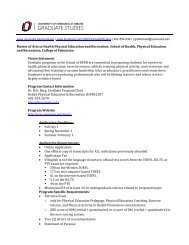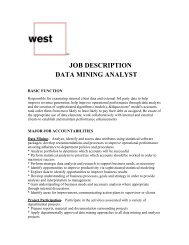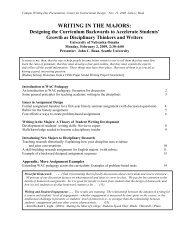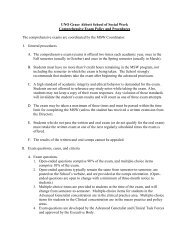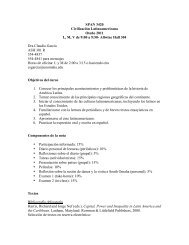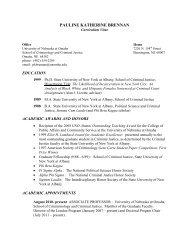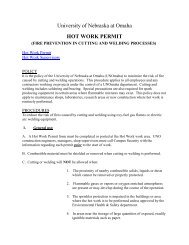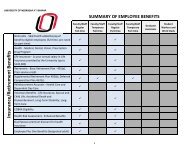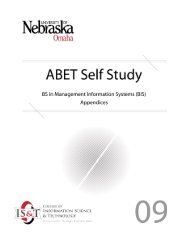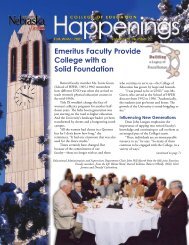Bloodborne Pathogen Exposure Control Plan - University of ...
Bloodborne Pathogen Exposure Control Plan - University of ...
Bloodborne Pathogen Exposure Control Plan - University of ...
You also want an ePaper? Increase the reach of your titles
YUMPU automatically turns print PDFs into web optimized ePapers that Google loves.
BLOODBORNE PATHOGEN EXPOSURE CONTROL PLAN<br />
UNO Campus Safety Policy<br />
POLICY<br />
It is the policy <strong>of</strong> the <strong>University</strong> <strong>of</strong> Nebraska at Omaha (UNO) to protect employees who, in the<br />
course <strong>of</strong> their work, may contact bloodborne pathogens (human body fluids and tissues). For<br />
additional information regarding pathogens, refer to Biosafety Guidelines UNMC/UNO<br />
(research issues) and the Institutional Policy on Infectious Diseases (copies on file in<br />
Environmental Health and Safety Office).<br />
EXPOSURE DETERMINATION<br />
1. <strong>Exposure</strong> determinations identify who will receive training and be <strong>of</strong>fered Hepatitis B (HBV)<br />
vaccination. These determinations also identify what measures must be taken to minimize<br />
exposure incidents. <strong>Exposure</strong> determination has been separated into three classifications:<br />
CLASS I is a listing <strong>of</strong> those job titles in which all employees have potential for occupational<br />
exposure to human blood, body fluids, or other infectious materials. Employees (including<br />
student employees) in Class I will receive annual training and be <strong>of</strong>fered HBV vaccination.<br />
CLASS II is a listing <strong>of</strong> those job titles whose tasks may result in occupational exposure.<br />
Employees (including student employees) in Class II will also receive annual training and be<br />
<strong>of</strong>fered HBV vaccination. CLASS III are employees in areas where injuries are likely to occur.<br />
Individuals in Class III will receive training every three years.<br />
Examples <strong>of</strong> tasks that place an individual at risk are listed in Appendix A. Class determinations<br />
are made by identifying the tasks that may lead to bloodborne pathogen exposure and by<br />
confirming that the tasks are part <strong>of</strong> an individual's normal job responsibility. Assisting or<br />
rendering first aid to an employee or student is not considered an employment related risk factor<br />
unless it is part <strong>of</strong> your normal job responsibility.<br />
2. Using the form provided (Form I), department chairpersons must identify by job description<br />
reasonably anticipated exposure to human body fluids and tissues. Determination must be made<br />
without regard to personal protective equipment or frequency <strong>of</strong> exposure. Departments must<br />
send the list to the Environmental Health and Safety Office for review by the <strong>Bloodborne</strong><br />
<strong>Pathogen</strong> <strong>Exposure</strong> <strong>Control</strong> Committee. Lists must be reviewed annually, and when any new or<br />
modified tasks might affect employee exposure. Reviewed lists must be resubmitted by October<br />
1 each year.<br />
A. Department Chairpersons are responsible for seeing that the methods used to protect<br />
employees are based on universal precautions. Methods will be reviewed by the <strong>Bloodborne</strong><br />
<strong>Pathogen</strong> <strong>Exposure</strong> <strong>Control</strong> Comm.<br />
B. Training will be scheduled by the employee's department. (See Training and Recordkeeping.)<br />
EXPOSURE CONTROL - WORK PRACTICES
1. Engineering and workplace controls (see 2-8 below) must be used to eliminate or minimize<br />
exposure. Personal protective equipment, i.e., gloves, masks, faceshields, must be used whenever<br />
there is an exposure potential.<br />
2. Hand-washing facilities must be available when feasible.<br />
A. Employees must wash their hands immediately upon direct skin contact and always after<br />
removal <strong>of</strong> gloves or other protective equipment.<br />
B. Flush eyes and/or mucous membrane areas immediately with water if those areas have come<br />
into contact with blood.<br />
3. Sharps (needles, scalpels, razor blades, contaminated glass) procedures:<br />
A. Do not bend, recap, or remove from syringes unless it can be demonstrated to the <strong>Bloodborne</strong><br />
<strong>Pathogen</strong> <strong>Exposure</strong> <strong>Control</strong> Committee that no other feasible method exists or that such action is<br />
required by a specific medical procedure.<br />
B. Shearing or breaking <strong>of</strong> contaminated needles is prohibited.<br />
C. Never reach into or force items into a sharps container. Containers must be accessible and<br />
located as close as possible to the area where sharps are used or found. They must be kept<br />
upright throughout use, replaced routinely, and not be allowed to overfill.<br />
D. Contaminated reusable sharps must be placed in containers that are puncture-resistant,<br />
labeled, and leakpro<strong>of</strong> on sides and bottom until properly reprocessed. Storage and processing<br />
procedures must not be used which require employees to reach by hand into these containers.<br />
4. Eating, drinking, smoking, applying cosmetics or lip balm, and handling contact lenses are<br />
prohibited in areas where there is a reasonable possibility <strong>of</strong> exposure.<br />
A. Food and drink must not be kept in refrigerators, freezers, shelves, cabinets, or countertops or<br />
benchtops where blood or other potentially infectious materials are present.<br />
B. Mouth pipetting/suctioning <strong>of</strong> blood or other potentially infectious material is prohibited.<br />
5. All procedures involving blood or other potentially infectious materials must be performed in<br />
a manner that minimizes splashing, spraying, spattering, and generation <strong>of</strong> droplets.<br />
6. Specimens <strong>of</strong> blood or other potentially infectious material must be placed in a container that<br />
prevents leakage during collection, handling, processing, storage, transport, or shipping.<br />
Specimen containers must be labeled and closed prior to being stored or transported when<br />
universal precautions are not utilized. Specimen containers shipped <strong>of</strong>f campus must be labeled.<br />
A. The primary container must be placed in a labeled or secondary container that prevents<br />
leakage when outside contamination <strong>of</strong> the primary container occurs.
B. The primary container must be placed in a labeled, puncture-resistant secondary container if<br />
the specimen could puncture the primary container.<br />
7. The worksite must be kept in a clean and sanitary condition. All equipment and work surfaces<br />
must be cleaned and disinfected after contact with blood or other potentially infectious material.<br />
Equipment that may become contaminated with blood or other potentially infectious materials<br />
must be examined prior to servicing or shipping and must be decontaminated if possible. The<br />
person using the equipment is responsible for decontamination.<br />
A. A label must be attached to the equipment stating which portions remain contaminated.<br />
B. Information must be conveyed to all affected employees, servicing representatives, and/or<br />
manufacturers prior to handling, servicing, or shipping so that appropriate precautions can be<br />
taken.<br />
8. RESEARCH LABORATORIES dealing with human pathogens must determine the level <strong>of</strong><br />
risk. They must meet the requirements as directed by the Biosafety Guidelines <strong>of</strong> UNMC/UNO.<br />
Reference that document for information on procedures in research laboratory environments.<br />
EXPOSURE CONTROL - PERSONAL PROTECTIVE EQUIPMENT<br />
Employees must use appropriate personal protective equipment, provided at no cost to the<br />
employee. It must be readily accessible and in a variety <strong>of</strong> sizes. Appropriate protective<br />
equipment includes but is not limited to: gloves, masks with face shield, CPR mouthpieces.<br />
Protective equipment must be worn under the following conditions:<br />
A. Gloves - must be worn when it is reasonably anticipated that the employee may have hand<br />
contact with blood or other body fluids and when handling or touching contaminated items or<br />
surfaces.<br />
1. Disposable gloves must be replaced as soon as practical when contaminated, or as soon as<br />
feasible if they are torn, punctured, or when their ability to provide an effective barrier is lost.<br />
Disposable gloves must not be washed or decontaminated for reuse.<br />
2. Utility gloves may be decontaminated and reused if the integrity <strong>of</strong> the gloves is not<br />
compromised.<br />
They must be discarded if cracked, peeling, torn, punctured, or exhibiting other signs <strong>of</strong><br />
deterioration.<br />
B. Masks and eye protection, (glasses, goggles or face shields) must be worn whenever there is<br />
the possibility that splashes, spray, or droplets <strong>of</strong> blood or other potentially infectious materials<br />
may be generated, which could contaminate eye, nose, or mouth.<br />
WASTE DISPOSAL AND LAUNDRY
1. Special precautions must be taken when disposing <strong>of</strong> infectious waste. All infectious waste<br />
must be put in red (biohazard) bags and placed in containers located at Health Services, Athletic<br />
Training, Campus Recreation (Central Issue), and Milo Bail Student Center. Biohazard waste is<br />
transported and disposed by a contractor.<br />
A. Mechanical means, such as a brush and dust pan, must be used to pick up potentially<br />
contaminated broken glassware.<br />
B. Broken contaminated glassware and sharps must be placed in sharps containers prior to<br />
disposal.<br />
NOTE: Glass disposal is a potential hazard for departmental and environmental personnel. Glass<br />
should be placed in a puncture-resistant container and labeled that it contains GLASS.<br />
2. Contaminated laundry must be handled as little as possible.<br />
A. Wet contaminated laundry must be placed and transported in bags or containers that prevent<br />
soak-through or leakage to the exterior.<br />
B. Employees who have contact with contaminated laundry must wear gloves and other<br />
appropriate personal protective equipment.<br />
HEPATITIS B VACCINE<br />
1. Hepatitis B vaccines must be available to Class I and II employees (including student<br />
employees), within 10 working days <strong>of</strong> assignment.<br />
A. The <strong>University</strong> will cover the cost <strong>of</strong> the vaccinations for <strong>University</strong> employees.<br />
B. Employees who choose not to be vaccinated must sign a declination form (Form II); they may<br />
later opt to receive the vaccine at no cost.<br />
2. Students with the potential for exposure to blood and other body fluids as part <strong>of</strong> their<br />
academic program must show pro<strong>of</strong> <strong>of</strong> initial vaccination with Hepatitis B to enter the program.<br />
The student must complete the vaccination series within six (6) months. The student is<br />
responsible for the vaccination costs.<br />
POST EXPOSURE PROCEDURES<br />
Following an exposure incident at UNO, employees and students must immediately report to<br />
Health Services during business hours. Students and employees must report to an emergency<br />
room (preferably UNMC) after hours. Employees must also notify their supervisor <strong>of</strong> the<br />
exposure incident.<br />
A. Employees, including student employees, who report to Health Services or the emergency<br />
department will receive a confidential medical evaluation and follow up which must include
testing the worker's blood upon consent (at no cost to the worker), post-exposure preventive<br />
treatment, and counseling.<br />
B. A copy <strong>of</strong> the evaluating health care pr<strong>of</strong>essional's written opinion must be provided to the<br />
employee within 15 days <strong>of</strong> the evaluation.<br />
LABELING<br />
1. Warning labels must be affixed to containers <strong>of</strong> infectious waste: refrigerators and freezers<br />
containing blood or other potentially infectious material, and other containers used to store,<br />
transport, or ship blood or other potentially infectious material except for the following<br />
exemptions.<br />
A. Red bags or red containers may be substituted for labels.<br />
B. Individual containers <strong>of</strong> blood or other potentially infectious materials that are placed in a<br />
labeled container during storage, transport, shipment or disposal.<br />
2. Labels must include the BIOHAZARD legend and symbol. Labels must be fluorescent orange<br />
or orange-red, or predominantly so, with lettering or symbols in contrasting color.<br />
A. Labels should be affixed as close as possible to the container by string, wire, adhesive, or<br />
another method that prevents loss or unintentional removal.<br />
B. Labels for contaminated equipment must meet the specifications above, and must state the<br />
portions <strong>of</strong> the equipment which remain contaminated.<br />
TRAINING AND RECORDKEEPING<br />
1. Trainers must be "certified" to conduct these classes. Training materials and instructor<br />
certification is available from Environmental Health and Safety. Contact Environmental Health<br />
and Safety for information and instructor availability.<br />
2. All employees will review and receive the <strong>Bloodborne</strong> <strong>Pathogen</strong> <strong>Exposure</strong> <strong>Control</strong> <strong>Plan</strong><br />
summary statement during employee orientation.<br />
3. For employees with occupational exposure (Classes I and II), annual training must be provided<br />
during working hours at no cost to the employee. Training must meet a specific set <strong>of</strong> criteria,<br />
and is available from Environmental Healt and Safety.<br />
4. Employees who work in areas where injuries occur more frequently due to the nature <strong>of</strong> their<br />
vocation or lab content (Class III) should receive initial training and refresher training every<br />
three years thereafter.<br />
5. Training records, which include the following, must be kept: dates <strong>of</strong> training sessions;<br />
contents and summary <strong>of</strong> training sessions; names and qualifications <strong>of</strong> persons conducting the
training; and names and job titles <strong>of</strong> all persons attending the training sessions. Training<br />
documentation forms are available from Environmental Health and Safety.<br />
6. Training records must be maintained for three years from the date on which the training<br />
occurs. Training records will be kept in Environmental Health and Safety and in the individual's<br />
department file.<br />
7. A medical record must be maintained in Health Services for each employee with occupational<br />
exposure. Among the<br />
items the record must contain are a copy <strong>of</strong> the employee's Hepatitis B status, dates <strong>of</strong> all<br />
Hepatitis B vaccinations and any medical records relative to the employee's ability to receive<br />
vaccination, a copy <strong>of</strong> all results <strong>of</strong> any post-exposure evaluations and follow-up procedures, and<br />
a copy <strong>of</strong> the information provided by the health care pr<strong>of</strong>essional, if applicable.<br />
A. Medical records will be kept confidential and not disclosed or reported without the<br />
employee's written consent, except as required by law.<br />
B. The records must be maintained for at least the duration <strong>of</strong> employment plus 30 years.<br />
ENFORCEMENT<br />
Employees not complying with the provision <strong>of</strong> this <strong>Plan</strong> will be subject to the disciplinary<br />
measures outlined in the UNO employee handbook.<br />
10/26/95<br />
APPENDIX A<br />
<strong>Exposure</strong> Determination<br />
Tasks that may involve exposure to bloodborne pathogens include, but are not limited to the<br />
following:<br />
CLASS EXAMPLES<br />
Administering vaccines or injections to humans<br />
Administering first aid or CPR<br />
Touching broken skin or mucous membranes<br />
Handling, obtaining or performing tests with human body specimens<br />
Cleaning surfaces or equipment that may be contaminated with<br />
bloodborne pathogens<br />
Handling laundry that may be contaminated with bloodborne pathogens<br />
Disposing <strong>of</strong> biohazard waste "red bags" or "sharps" containers.<br />
Class I<br />
Job Title
Class II<br />
Class III<br />
Nurse<br />
Security Officer<br />
Athletic Trainer<br />
Custodian<br />
Job Title<br />
Graduate Asst.,<br />
Campus Rec<br />
Student Worker,<br />
Campus Rec<br />
Job Title<br />
Faculty - Chemistry,<br />
Biology<br />
Graduate Asst.-Chem.,<br />
Biol.<br />
Food Service<br />
<strong>Plan</strong>t Maint. and<br />
Utilities<br />
Grounds<br />
Tasks and Assignments<br />
Building Mgr, responds<br />
to injury scene and<br />
assists as necessary<br />
Field Supervisor, " "<br />
Central Issue - handles<br />
soiled laundry, etc.<br />
Tasks and Assignments<br />
Assist injured students<br />
in lab<br />
Assist injured students<br />
in lab<br />
Assist injured coworkers<br />
Assist injured coworkers<br />
Assist injured coworkers<br />
TRAINING AND VACCINATION SUMMARY<br />
TRAINING<br />
CONTENT<br />
FREQUENCY<br />
HEPATITIS B<br />
VACCINATION<br />
NEW<br />
EMPLOYEES<br />
<strong>Control</strong> <strong>Plan</strong> Summary<br />
During new<br />
employee orientation<br />
No<br />
CURRENT<br />
EMPLOYEES<br />
<strong>Control</strong> <strong>Plan</strong> Summary<br />
Once through<br />
Department staff<br />
No<br />
CLASS I & II<br />
(Employees and<br />
Students)<br />
1. <strong>Control</strong> <strong>Plan</strong><br />
2. Video*<br />
Annually<br />
Yes
CLASS III<br />
Employees in high<br />
injury areas<br />
1. <strong>Control</strong> <strong>Plan</strong><br />
2. Video*<br />
(optional)<br />
Every 3 years<br />
No<br />
* Video - <strong>Bloodborne</strong> <strong>Pathogen</strong>s, by Summit Training 1992




